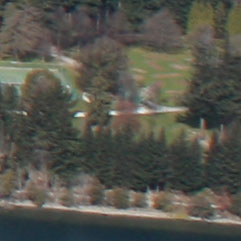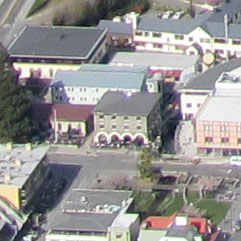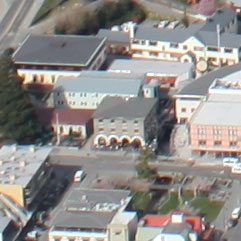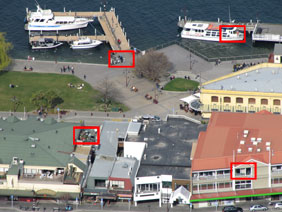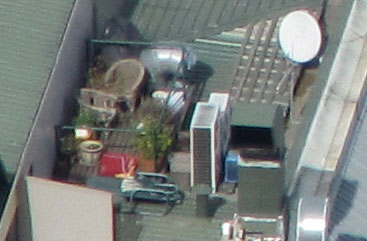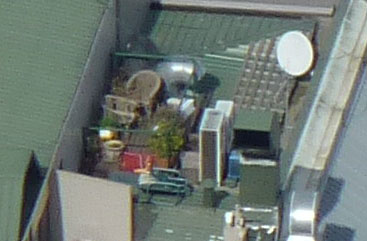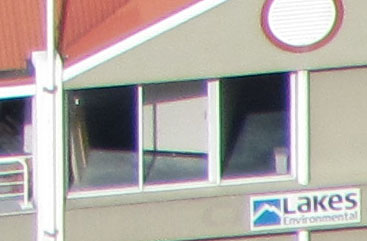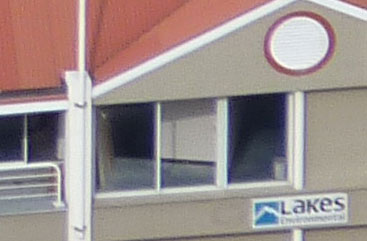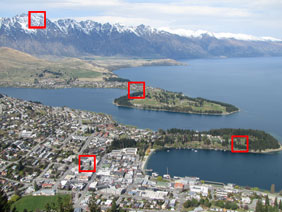|
Support this site by checking prices below |
 |
| |
|
To compare real-life performance we shot the same scene with the Canon PowerShot SX20 IS, Panasonic Lumix FZ38 / FZ35 and Canon EOS 450D / XSi within a few moments of each other using their best quality JPEG and lowest ISO settings. The lenses on each camera were adjusted to deliver the same vertical field of view. |
|
The image above was taken with the Canon PowerShot SX20 IS in Program mode at 6mm f4 and with a sensitivity of 80 ISO. The original Fine JPEG measured 3.72MB; the Panasonic file measured 3.52MB, which makes this one of the few times the Canon delivered a larger file. Note the FZ38 / FZ35 automatically selected an aperture of f5.6 by default for this composition, but we used Program Shift to match the f4 setting of the Canon SX20 IS and to better avoid diffraction. The crops are taken from the areas marked by the red squares and presented here at 100%. Note the Canon 450D / XSi captures wider 3:2 aspect ratio images, so by matching the vertical field of view, we’re effectively treating the DSLR here as a 10.8 Megapixel camera, delivering 4:3 shaped images. Starting with the first row of crops taken from the mountain ridge in the upper left corner, it’s obvious both Canon’s are suffering from some coloured fringing, whereas it’s completely absent on the Panasonic. This is a repeat of our findings with their predecessors, where we discovered the Panasonic’s fringe-free performance is not due to superior optics, but simply digital correction in-camera.
This correction is applied automatically to JPEGs whether you like it or not, but can be disabled when processing RAW files – and doing so reveals a similar degree of fringing to the Canon. While this proves their optics are similarly corrected, Panasonic’s digital reduction of coloured fringing remains a valuable feature and one that delivers nice, clean looking results. It’s been particularly beneficial in our telephoto results further down this page.
From this point on though, the remaining samples from both super-zooms look very similar. Previously we noted the FZ28 had looked a little softer than the SX10 IS, but this was down to diffraction at the smaller aperture automatically selected by the Panasonic in its Program mode (explained lower down this page). With both cameras using the same aperture of f4 here, the degree of detail recorded is essentially the same.
In terms of image processing, the default settings of the Canon SX20 IS are slightly punchier than the Panasonic FZ38 / FZ35, delivering a little extra contrast and sharpening, but that’s something you can adjust on both cameras if desired. One final note: look very closely in the arches of the central building on the fourth row of crops and you’ll see a tiny amount of fringing on the Canon SX20 IS sample which again has been corrected on the Panasonic.
In the meantime, the EOS 450D / XSi is recording a similar degree of detail, with slightly restrained image processing resulting in a softer image, characteristic of a DSLR. The biggest differences between the DSLR and super-zooms here is the optical correction of their respective lenses, with the DSLR kit lens suffering in some areas – seen most obviously in the third crop. So if you’re shooting at the lowest sensitivities under bright conditions, the super-zooms could deliver a superior overall result (accepting a little background noise when viewed at 100%). The major difference in quality comes at higher sensitivities where the DLSR with its bigger sensor takes a decisive lead.
You can see that in action in our High ISO Results page, but if you can stick around a few moments longer, scroll down to see how both super-zooms compare when zoomed-into their longest focal lengths. | 







